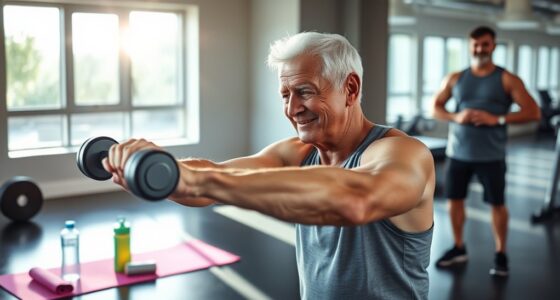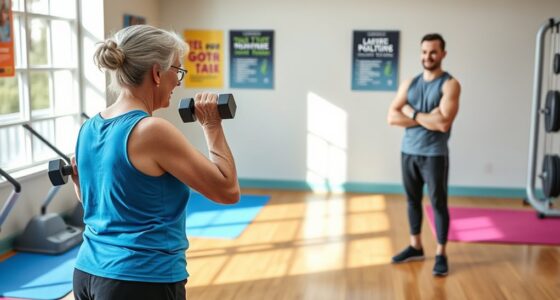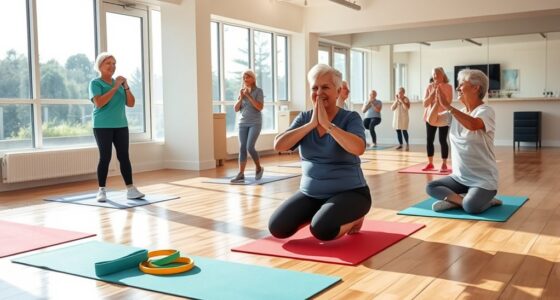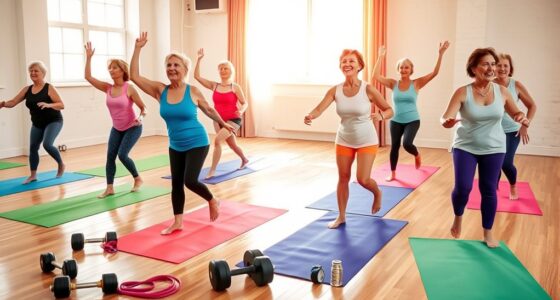To transform your golden years, start incorporating a mix of balance, strength, and low-impact exercises into your routine. Activities like swimming, chair yoga, and walking not only boost your energy but also improve your mobility and independence. Aim for strength training at least twice a week while including flexibility exercises to enhance your range of motion. By embracing these workouts, you’ll elevate your overall health and well-being. There’s so much more you can discover about an active lifestyle!
Key Takeaways
- Incorporate low-impact exercises such as walking, swimming, or cycling to enhance cardiovascular health and endurance without stressing joints.
- Engage in balance exercises like Tai Chi or heel-to-toe walking at least three times a week to reduce fall risk.
- Include strength training exercises using bodyweight, resistance bands, or light dumbbells twice a week to maintain muscle mass and bone density.
- Prioritize flexibility and mobility exercises to improve joint range of motion and reduce stiffness, supporting daily activities and overall wellness.
- Participate in community fitness programs to foster social connections and accountability, enhancing motivation and emotional support.
The Health Benefits of Exercise for Seniors
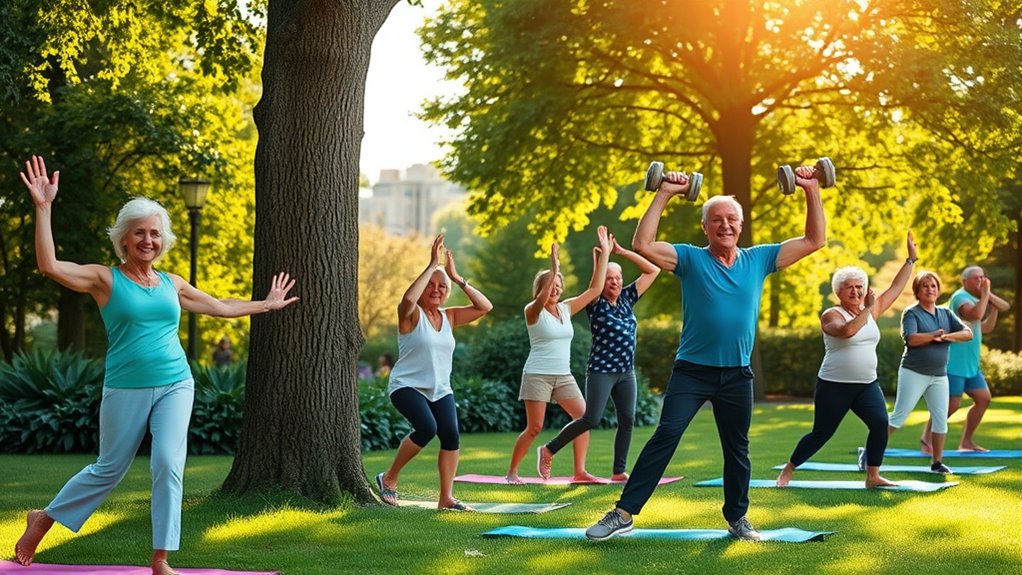
The health benefits of exercise for seniors are immense. It reduces the risk of chronic diseases like heart disease and diabetes, enhancing your longevity and quality of life. Regular physical activity can also improve cognitive function, helping you stay mentally sharp as you age. Additionally, engaging in regular exercise promotes better sleep patterns, which can improve overall health and recovery. Regular outings with pets can also provide socialization opportunities, enhancing emotional well-being. Furthermore, maintaining an active lifestyle can help reduce the risk of infections, as a healthy immune system is crucial for overall well-being.
Exercise significantly lowers chronic disease risks, promoting a longer, healthier life for seniors.
By improving muscle strength and maintaining bone density, you can prevent falls and injuries, which is essential as balance declines with age.
Additionally, regular physical activity increases energy levels and enhances mood, cutting the risk of depression and dementia nearly in half.
You’ll also enjoy better sleep quality and reduced joint pain, making daily tasks easier and allowing you to stay more active and independent. Regular exercise, like walking or swimming, can help prevent obesity and related health issues, contributing to overall well-being.
Importance of Independence and Quality of Life
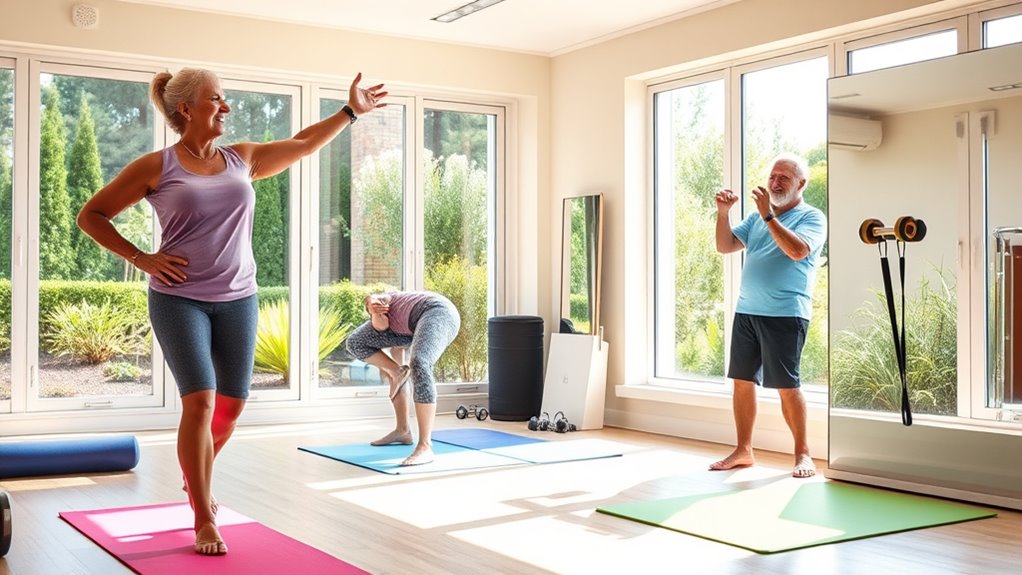
Independence is essential for seniors, as it directly influences their quality of life and overall happiness.
Regular exercise plays a pivotal role in maintaining this independence by enhancing your physical abilities and self-sufficiency. By staying active, you can enjoy:
- Improved ability to perform daily tasks like walking and cooking
- Greater confidence that reduces reliance on caregivers
- A 23% lower risk of falls, allowing safer navigation in your environment
Engaging in regular exercise not only boosts your physical health but also uplifts your mental well-being, reducing symptoms of depression and improving your mood. Additionally, incorporating gentle stretching before workouts can help alleviate discomfort and enhance flexibility. Regular activity can also help combat common health concerns associated with aging, promoting overall wellness. Furthermore, participating in digital literacy programs can enhance your ability to connect with loved ones, making your social interactions more enjoyable. Engaging in physical activities can also improve your cognitive development, which is crucial for maintaining mental sharpness as you age. Moreover, staying active in nature through camping locations can provide a refreshing escape and promote a sense of peace.
Key Exercises for Enhancing Balance
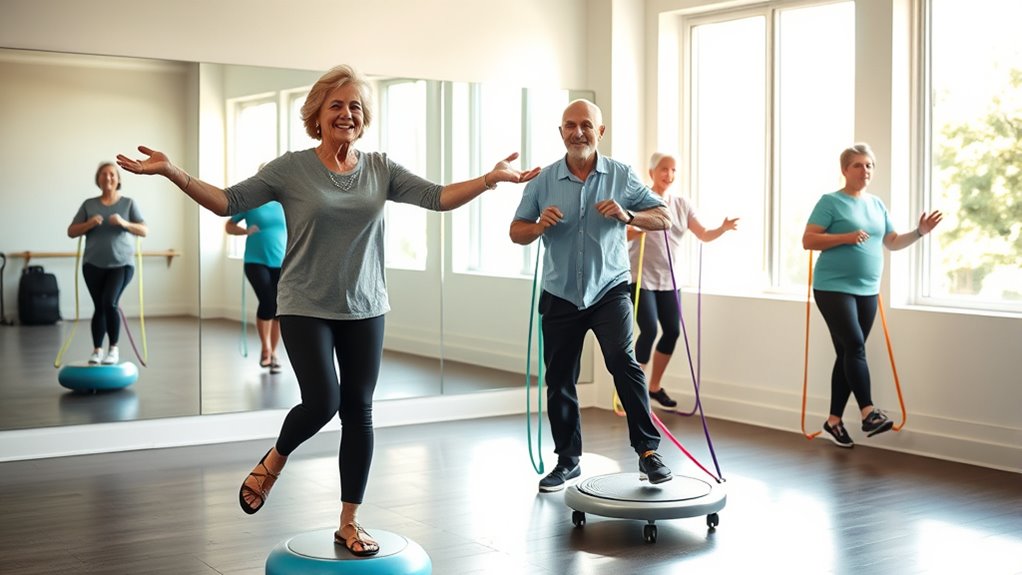
Maintaining independence goes hand in hand with enhancing your balance. Engaging in balance exercises at least three times a week can greatly reduce your risk of falls, which affect one in four older Americans annually.
Simple activities like walking heel-to-toe and standing from a seated position improve your coordination and stability, crucial for staying active. Incorporating low-impact exercises like Tai Chi or chair yoga is also effective; they enhance balance while being gentle on your joints.
Additionally, exercises that strengthen your back, abdomen, and legs, such as wall push-ups and calf raises, are essential for overall balance. By committing to these exercises for seniors, you’ll not only feel safer but also enjoy a more active and fulfilling lifestyle.
Building Strength: Essential Workouts for Seniors
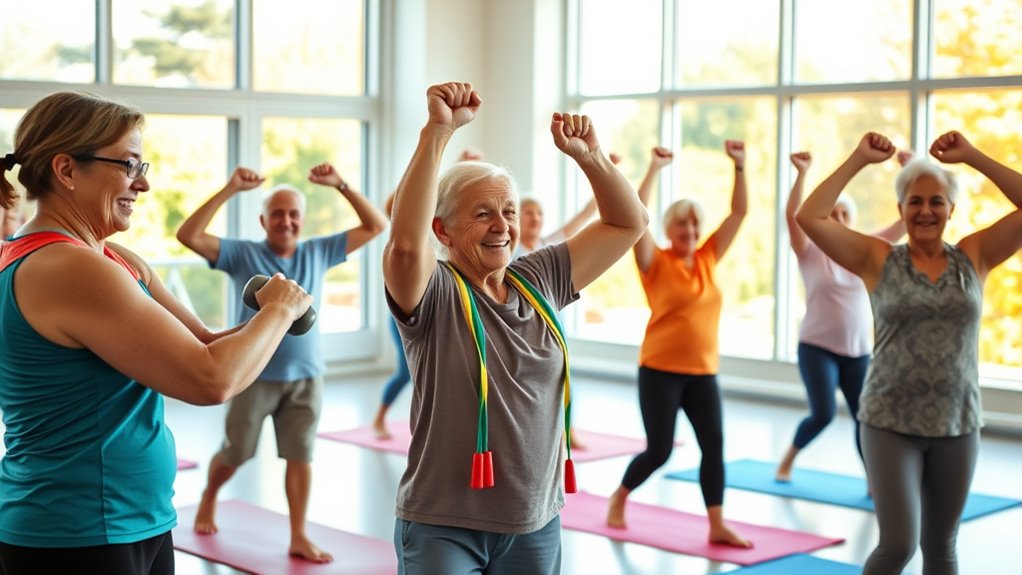
Strength training is essential for you as a senior, helping to maintain muscle mass and bone density. By incorporating simple exercises into your routine, you can boost your mobility and independence. Additionally, creating transforming spaces that are conducive to exercise can further enhance your strength training efforts. Engaging in regular physical activity also promotes practical skills like crafting simple exercise equipment, which can enhance your workout experience. Regular physical activity can also improve indoor air quality, making your workout environment more pleasant and healthy. Moreover, studies show that physical activity can significantly reduce the risk of chronic diseases in seniors. Incorporating home security systems into your environment can also provide peace of mind, allowing you to focus on your fitness without worry. Let’s explore some recommended workouts that will keep you strong and safe.
Benefits of Strength Training
Engaging in strength training offers seniors numerous benefits that greatly enhance their quality of life. By incorporating strength exercises into your routine, you’ll not only maintain muscle mass and bone density but also enjoy greater independence in daily activities.
Here are some key advantages:
- Reduce the risk of osteoporosis and fractures, keeping your bones strong. Additionally, engaging in regular strength training can lead to significant energy savings, allowing you to enjoy a more active lifestyle. Furthermore, incorporating specific exercises can target major muscle groups effectively. Research shows that maintaining consistent routines can significantly boost your overall physical health.
- Improve balance and mobility, making everyday tasks easier and safer. Regular strength training can also help boost energy levels and enhance sleep quality, promoting overall well-being. As you develop a consistent routine, you’ll notice improvements in your overall physical health and mental outlook.
With tailored bodyweight exercises and resistance training, you can safely reap these benefits, contributing to a healthier lifestyle. Additionally, regular strength training even helps alleviate symptoms of chronic diseases, ensuring you stay active and engaged in your golden years, as market research identifies target audience and helps tailor programs to meet individual needs.
Regular strength training even helps alleviate symptoms of chronic diseases, ensuring you stay active and engaged in your golden years.
Recommended Exercises for Seniors
Recommended exercises for seniors include bodyweight movements like wall push-ups and calf raises, which improve strength without heavy equipment. Incorporating resistance bands and light dumbbells can enhance your strength training routine, allowing you to target major muscle groups safely. Additionally, regular physical activity is crucial for overall health and well-being as you age, as it can also help release trauma stored in the body through movement. Understanding the importance of establishing clear boundaries in your exercise routine can help you stay focused and committed. Aim for at least two days of muscle-strengthening activities each week to maintain muscle mass and bone density, reducing the risk of osteoporosis and fractures. Engaging in astrological compatibility may also foster a positive mindset that encourages continued physical activity.
Regular strength training not only boosts physical health but also improves balance and stability, considerably lowering fall risk. Additionally, maintaining a balanced diet rich in nutritional benefits is essential for supporting your exercise routine and overall health.
Embracing these exercises will help you lead a more active lifestyle and maintain your independence as you age.
Low-Impact Activities for Joint Health

While you might think that intense workouts are the only way to stay fit, low-impact activities can be just as beneficial for your joint health.
Engaging in these gentle exercises helps you maintain mobility and strength while minimizing stress on your joints. Incorporating low-impact workouts into your routine is essential for reducing the risk of falls and injuries.
Gentle exercises enhance mobility and strength while protecting your joints, crucial for preventing falls and injuries.
Consider these activities:
- Swimming: A full-body workout that’s easy on the joints.
- Chair Yoga: Increases flexibility and strength without strain.
- Water Aerobics: Fun and effective for building endurance in a supportive environment.
Cardiovascular Exercises for Energy Boost

Cardiovascular exercises can be a game-changer for boosting your energy levels.
Low-impact options like swimming and cycling not only get your heart pumping but also support joint health.
Plus, joining a group class or walking club can make your workouts more enjoyable and help you connect with others, enhancing your motivation and mental well-being.
Low-Impact Cardio Options
Low-impact cardio options can greatly boost your energy levels and overall fitness, especially as you age.
These exercises minimize stress on your joints while enhancing cardiovascular health. Engaging in low-impact activities for at least 150 minutes each week will help you feel more energetic and improve your overall well-being.
- Swimming: A great way to get your heart pumping without joint pain.
- Cycling: Perfect for building endurance and strength while being gentle on your knees.
- Walking: Simple yet effective; it promotes heart health and can be done anywhere.
Incorporating these exercises into your routine can lead to better sleep quality, improved mood, and reduced risk of falls, helping you thrive during your golden years.
Social Exercise Benefits
Participating in social exercise can considerably enhance your energy levels and overall well-being. Engaging in cardiovascular activities like walking, swimming, or cycling releases endorphins, which boost your stamina and mood.
When you join group classes or dance sessions, the social exercise benefits become even more pronounced, as they motivate you to stay consistent and accountable. Regular cardiovascular workouts not only elevate your physical health but also improve mental health by reducing symptoms of depression and anxiety.
Aim for at least 150 minutes of moderate-intensity exercise weekly, and you could lower your risk of chronic diseases by up to 40%. Ultimately, these activities foster social interaction, alleviating loneliness and enhancing your overall health and wellness during your golden years.
Mobility Exercises to Maintain Flexibility
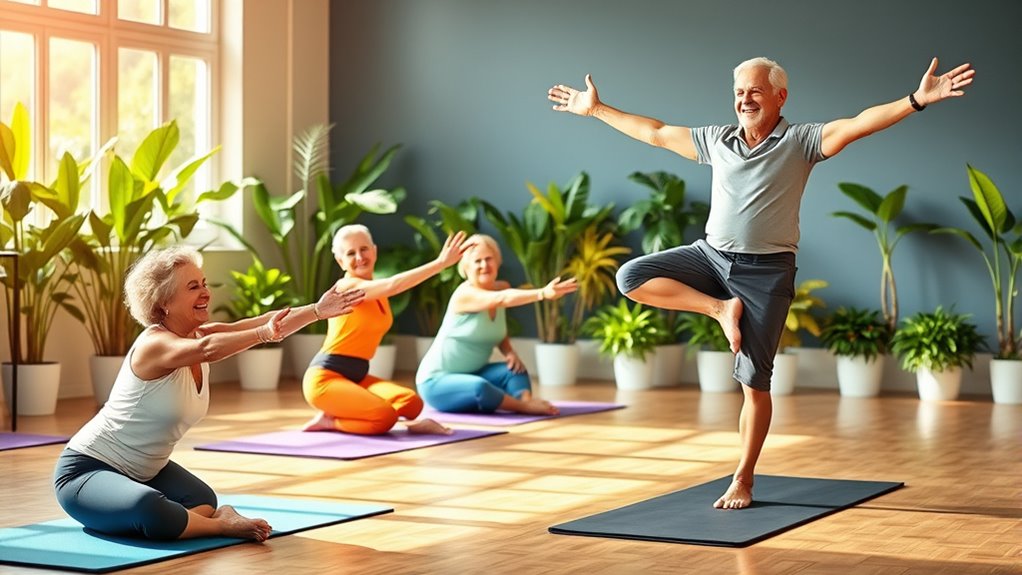
As you age, maintaining flexibility becomes vital for enhancing your overall mobility and daily functioning.
Maintaining flexibility is crucial for improving mobility and daily functioning as we age.
Incorporating mobility exercises into your routine not only reduces stiffness but also improves your joint range of motion, making everyday tasks easier and safer.
Regular practice can greatly aid in fall prevention, as better balance and coordination are essential for avoiding injuries.
- Neck stretches to relieve tension
- Shoulder rolls to enhance upper body mobility
- Ankle circles for improved lower leg flexibility
Exercises Seniors Should Avoid
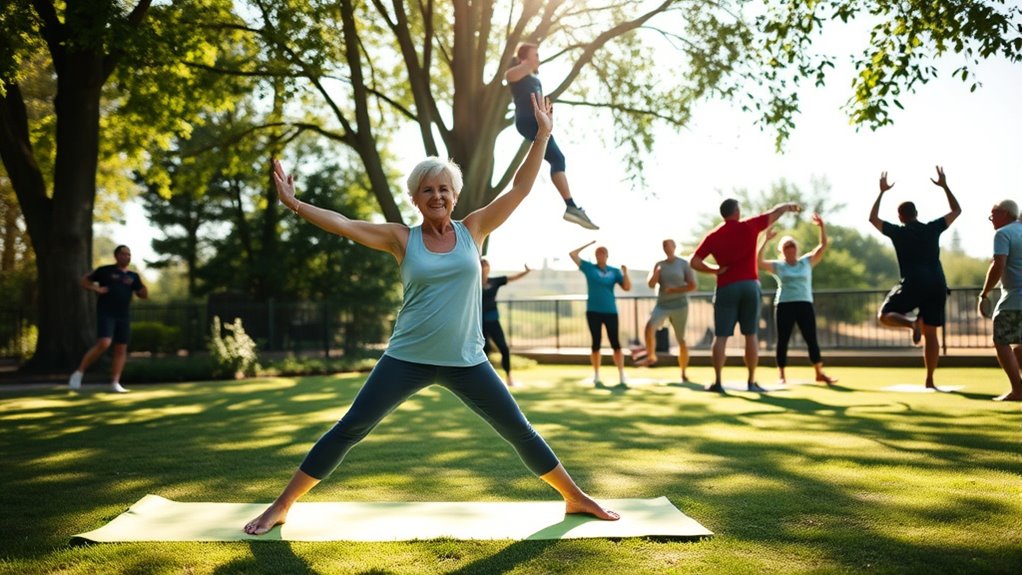
While mobility exercises can greatly enhance flexibility and reduce the risk of falls, it’s equally important to know which activities to steer clear of.
High-impact exercises, like long-distance running, can worsen joint issues and lead to fatigue. Avoid abdominal crunches, as they can strain your back and neck, especially if you have existing health conditions.
High-intensity interval training (HIIT) poses a risk of falls due to rapid movements. Additionally, weight training exercises requiring complex movements, such as deadlifts, should be approached cautiously or avoided entirely.
Finally, steer clear of activities that demand quick changes in direction, like rock climbing, as they notably increase your risk of falls.
Prioritizing safe exercise helps you stay active and healthy.
Creating a Supportive Community for Wellness
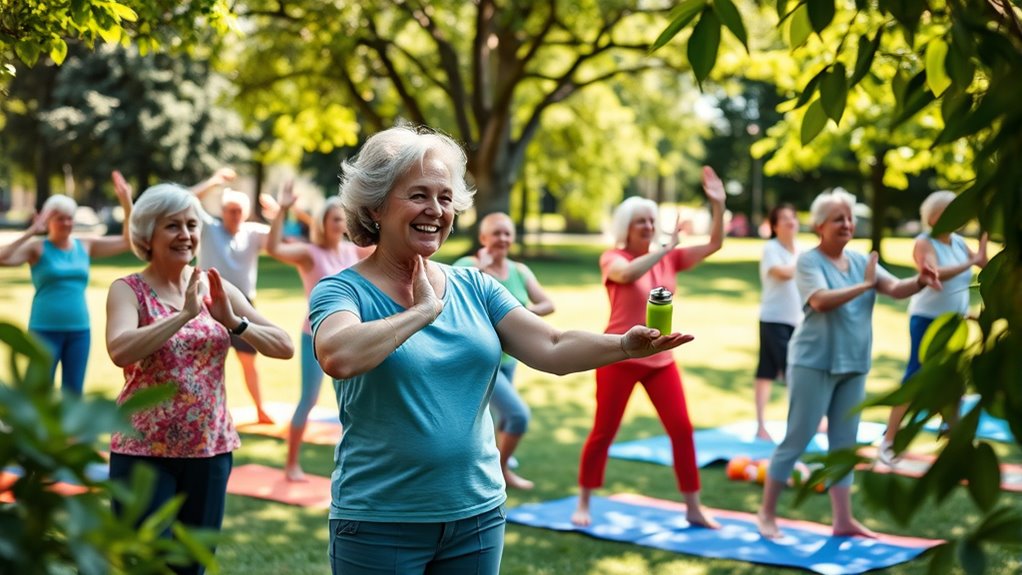
Creating a supportive community for wellness can greatly enhance your fitness journey as a senior. Being part of a senior lifestyle community offers you a unique chance to engage in structured fitness programs designed for your needs.
Here’s how a supportive community can benefit you:
- Social Interaction: Group exercises foster friendships, helping you feel connected and motivated.
- Accountability: Sharing your fitness progress with others encourages commitment to your goals.
- Mental Well-being: Exercise promotes both physical health and emotional support, boosting your overall quality of life.
Participating in community fitness activities not only enhances your physical health but also enriches your mental well-being.
Embrace the camaraderie and support of your community, and watch your fitness journey flourish!
Frequently Asked Questions
What Is the Number One Exercise for Seniors?
The number one exercise for you as a senior is walking. It’s low-impact, easy to do, and helps improve your cardiovascular health.
By walking just 30 minutes a day, you can meet the recommended exercise guidelines and boost your overall well-being.
Plus, incorporating balance exercises, like heel-to-toe walking, can reduce your fall risk.
Joining a walking group can also enhance social connections and keep you motivated, making it a fun way to stay active.
What Is the Number 1 Exercise to Increase Balance in Seniors?
Imagine gliding through gentle movements, your body swaying like a leaf in the breeze.
The number one exercise to increase balance in seniors is Tai Chi. As you practice its flowing motions, you’ll notice your stability and coordination improving.
Regular sessions not only enhance your lower body strength and flexibility but also reduce the risk of falls by nearly 50%.
Embrace Tai Chi, and you’ll feel more confident and secure in your daily movements.
What Is the AARP #1 Exercise for Seniors?
The AARP identifies walking as the #1 exercise for seniors. It’s accessible, low-impact, and great for your heart.
By walking regularly, you can easily meet the recommended 150 minutes of moderate-intensity activity each week, which boosts your overall health.
Walking not only helps reduce the risk of chronic diseases but also improves your balance and coordination, essential for fall prevention.
Plus, it elevates your mood and energy levels, enhancing your quality of life.
What Is the Best Exercise to Lose Belly Fat for Seniors?
Think of your belly fat as a stubborn cloud that won’t drift away. To tackle it, you should focus on low-impact aerobic exercises like walking or swimming, combined with strength training at least twice a week.
These activities boost metabolism and maintain muscle mass, essential for burning fat. Don’t forget core-strengthening exercises, too!
Aim for 150 minutes of activity weekly, and you’ll be on your way to a healthier you.
Conclusion
So, while you might think lounging around is the secret to enjoying your golden years, it’s actually staying active that keeps the good times rolling. Embracing these workouts not only boosts your strength and flexibility but also sprinkles some fun into your routine. Remember, the more you move, the more you’re truly living. So grab those weights, join a class, and surprise yourself with how vibrant life can be—because who knew getting fit could feel this good?


